MARIANI’S
Virtual Gourmet
April
12, 2020
NEWSLETTER
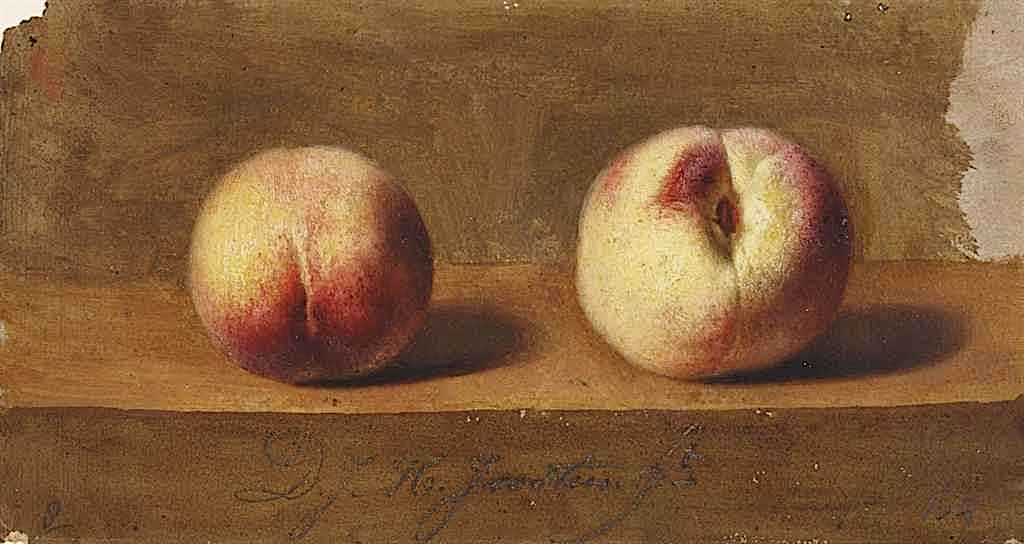
❖❖❖
IN THIS ISSUE
IF YOU CAN'T TRAVEL NOW, HERE ARE SOME OF
THE BEST TRAVEL BOOKS FOR A HOUSEBOUND READER
By John Mariani
NEW YORK CORNER
LOVE AND PIZZA
Chapter Three
By John Mariani
BELOVED ITALIAN-AMERICAN
RESTAURATEUR PASSES AWAY
By John Mariani
NOTES FROM THE WINE CELLAR
DOMAINE BOUSQUET WINES OF ARGENTINA
By John Mariani
❖❖❖
IF YOU CAN'T TRAVEL NOW, HERE ARE SOME OF
THE BEST TRAVEL BOOKS FOR A HOUSEBOUND READER
By John Mariani
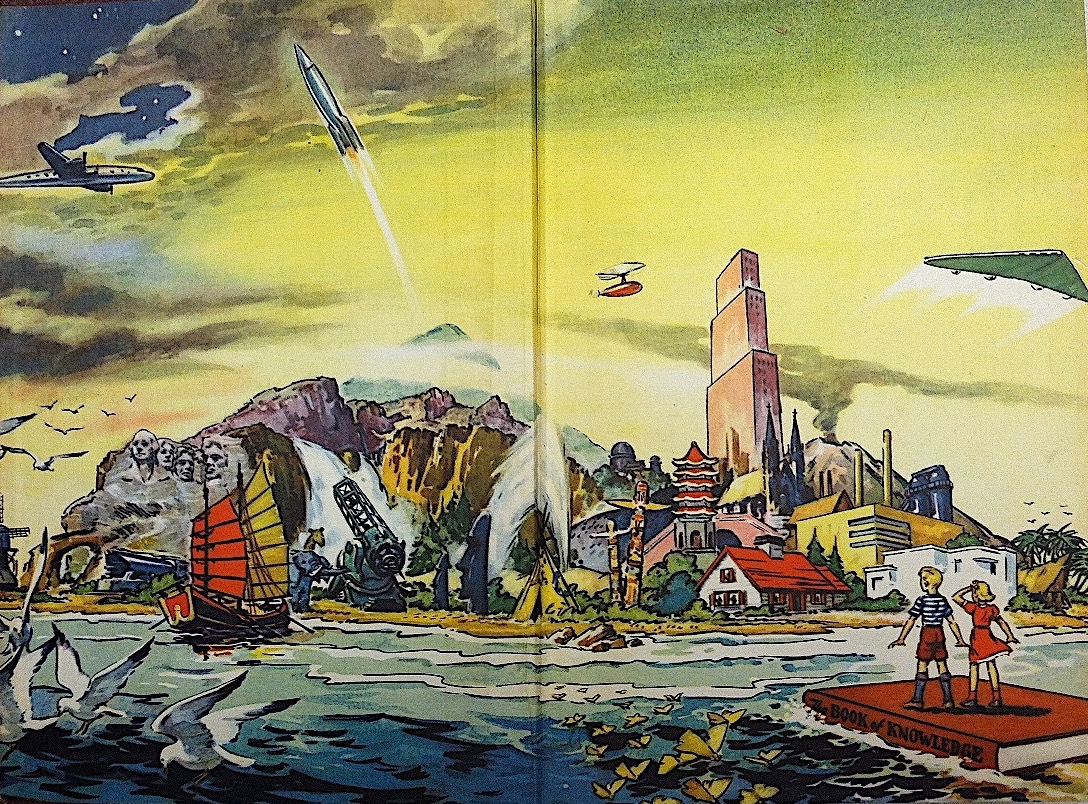
End Papers of The Book of Knowledge
As
every travel writer and editor knows, most
people who read books and magazine articles
about far-flung or even close-by places to visit
never actually do. They might well pack a
guidebook in their luggage to consult for the
age of Rome’s Pantheon or the height of the
Eiffel Tower or where to find a fried chicken
dinner house in Omaha, but the more exotic a
place is the less likely people are to get
there. The authors of the best travel books,
therefore, do not seek to mark out routes, give
hotel prices or locations of spice bazaars but
instead try to give a thrilling panorama on the
culture and natural beauty of a place and what
makes it unique from others. And they do it
without the advantage of an expense account.
So, at a time when travel is
effectively prohibited, here are some of the
best books written by the best authors for the
housebound armchair traveler.
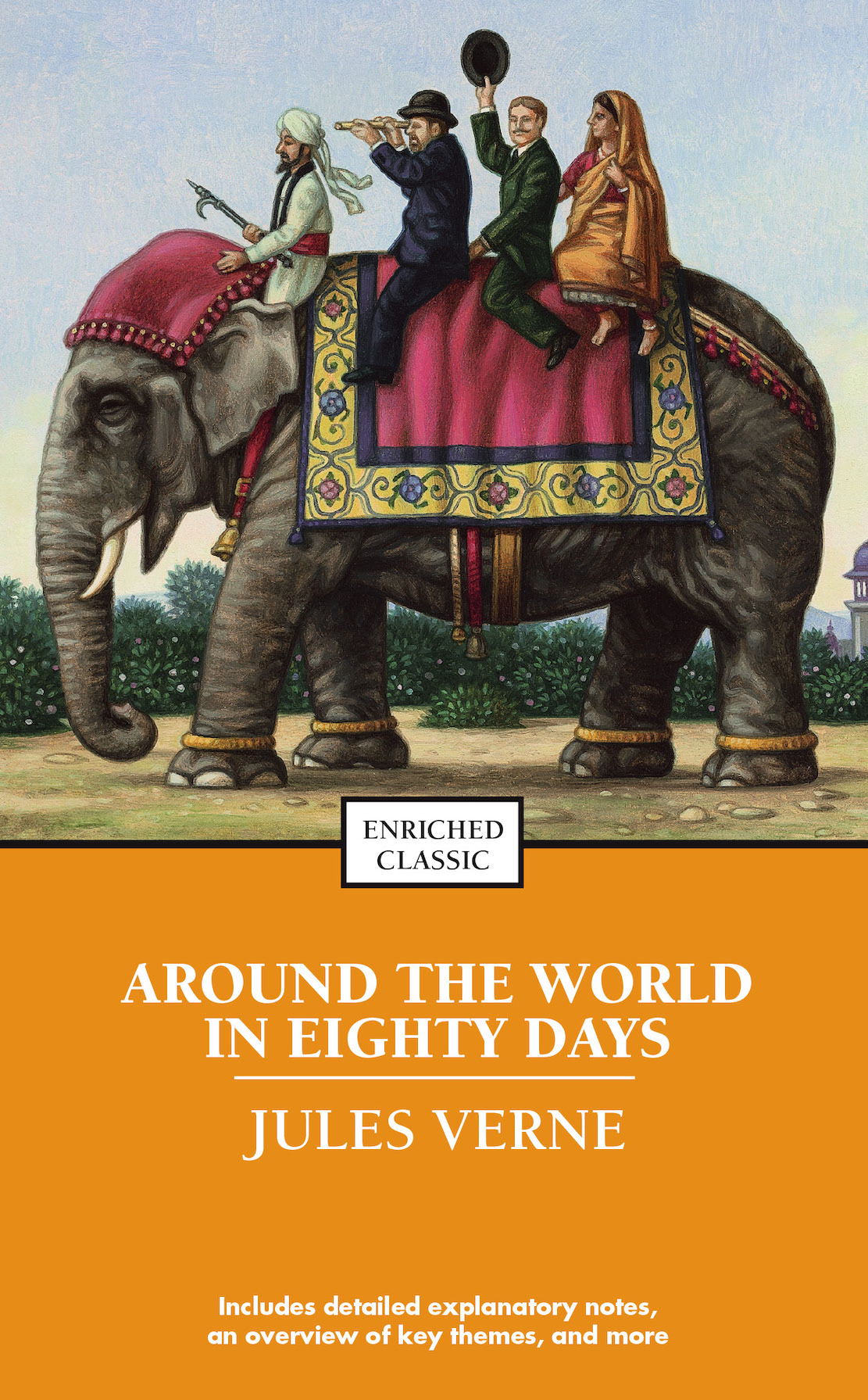 Around
the World in Eighty Days (1872) by Jules Verne—Although
the enchanting movie made from Verne’s novel is
now more famous, upon publication the original had
been an international bestseller and Verne’s most
popular book.
Verne himself had never actually
circumnavigated the world—he left France only once
to sail around Europe—instead using his
imagination and research to produce science
fiction stories along with Eighty Days,
which was filled with headlong adventures by
Phineas Fogg from London to Suez, Bombay, Hong
Kong, Yokohama, San Francisco and New York, all to
win a small wager with his British club members. The
book is a fantasy of another time but gets to the
heart of what stimulates all human beings’ desire
to travel well beyond their safe zones. It also
demonstrates the technological triumphs of Verne’s
age, including America’s Transcontinental Railway,
the integration of India’s railroads and the
opening of the Suez Canal, three years earlier. As
a Frenchman, Verne could not help himself from
writing of his British hero, “As for seeing the town,
the idea never occurred to him, for he was the
sort of
Around
the World in Eighty Days (1872) by Jules Verne—Although
the enchanting movie made from Verne’s novel is
now more famous, upon publication the original had
been an international bestseller and Verne’s most
popular book.
Verne himself had never actually
circumnavigated the world—he left France only once
to sail around Europe—instead using his
imagination and research to produce science
fiction stories along with Eighty Days,
which was filled with headlong adventures by
Phineas Fogg from London to Suez, Bombay, Hong
Kong, Yokohama, San Francisco and New York, all to
win a small wager with his British club members. The
book is a fantasy of another time but gets to the
heart of what stimulates all human beings’ desire
to travel well beyond their safe zones. It also
demonstrates the technological triumphs of Verne’s
age, including America’s Transcontinental Railway,
the integration of India’s railroads and the
opening of the Suez Canal, three years earlier. As
a Frenchman, Verne could not help himself from
writing of his British hero, “As for seeing the town,
the idea never occurred to him, for he was the
sort of  Englishman who, on his
travels, gets his servant to do his sightseeing
for him.”
Englishman who, on his
travels, gets his servant to do his sightseeing
for him.”
Stories of Hawaii
by Jack London—This is a collection of many
stories London wrote during three long stays in
the Hawaiian islands—1907, 1915 and 1916—which he
loved at least as much as he did the Yukon
territory he made famous in books like The Call of
the Wild and White Fang.
In stories both heartwarming and tragic, with
enticing names like “On the Makaloa Mat,” “The
Tears of the Ah Kim” and “The Bones of Kahekili,”
the reader finds a wide-ranging gallery of
characters, both native and not, and of how the
islands had been impacted by immigrants and
developers. London’s prose, often regarded as
robust and sinewy, can be exotically beautiful
here, as when he writes of the “lofty Koolau
Mountains’s trade winds” as “soft breathings,
[when] the air grew heavy and balmy with perfume
of flowers and exhalations of fat, living soil.”
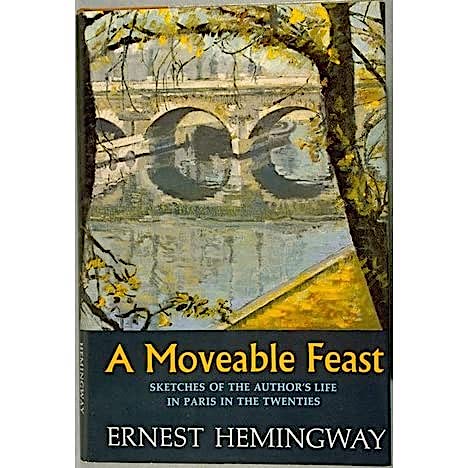 A
Moveable Feast (1964) by Ernest Hemingway—Hemingway
did not invent Paris, but he created both
fictional and non-fictional narratives about the
city that have became indelible, not least in A Moveable
Feast, a posthumous memoir about his
expatriate life in Paris with his wife Hadley,
“when we were very poor and very happy.” Ever
since its publication (as well that of The Sun Also
Rises and “The Snows of Kilimanjaro”)
travelers have viewed Paris through Hemingway’s
eyes and descriptions: the food and drink at the
brasseries like Les Cloiserie des Lilas (his
favorite), Café du Dôme and Lipp; the “false
spring” when he went to the Saint-Cloud race
track; autumn in the Luxembourg Gardens; the
market street of Rue Mouffetard, where he bought
mandarin oranges and chestnuts to nibble while he
wrote. In those memories Hemingway crystallized
the romance of a city as he
A
Moveable Feast (1964) by Ernest Hemingway—Hemingway
did not invent Paris, but he created both
fictional and non-fictional narratives about the
city that have became indelible, not least in A Moveable
Feast, a posthumous memoir about his
expatriate life in Paris with his wife Hadley,
“when we were very poor and very happy.” Ever
since its publication (as well that of The Sun Also
Rises and “The Snows of Kilimanjaro”)
travelers have viewed Paris through Hemingway’s
eyes and descriptions: the food and drink at the
brasseries like Les Cloiserie des Lilas (his
favorite), Café du Dôme and Lipp; the “false
spring” when he went to the Saint-Cloud race
track; autumn in the Luxembourg Gardens; the
market street of Rue Mouffetard, where he bought
mandarin oranges and chestnuts to nibble while he
wrote. In those memories Hemingway crystallized
the romance of a city as he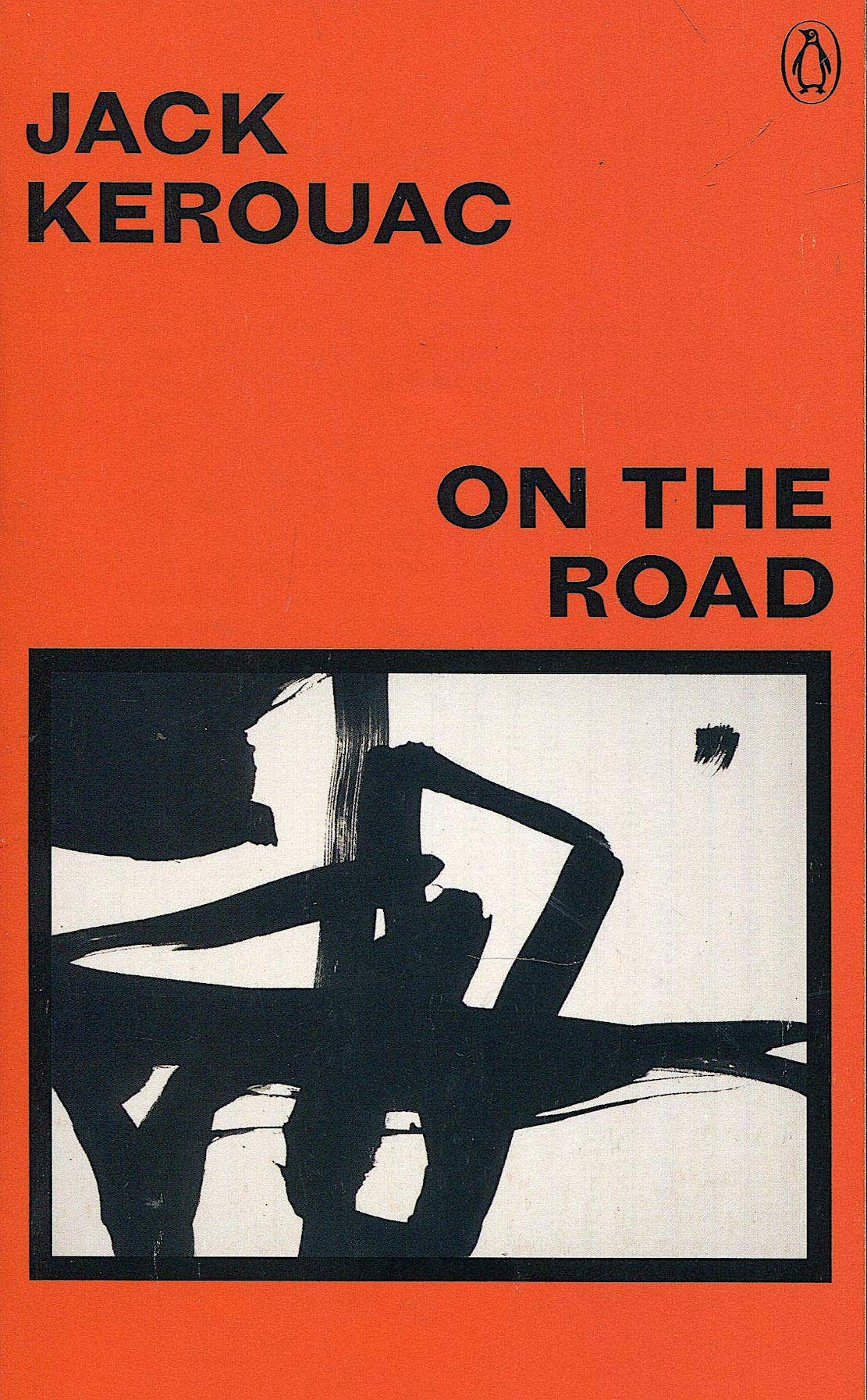 knew it and how we all wish to see
and taste it.
knew it and how we all wish to see
and taste it.
On the Road (1957) by Jack Kerouac—If Kerouac
needed anything it was to be restrained and edited
into an approachable form. The man just rambles on
and on. But he did so with a fresh, marvelous
open-eyed style that redeemed the old pioneer
notion that an American’s birthright is to follow
where the road may lead him, even after the west
was conquered and the Pacific Ocean was the
country’s limit. Like his companion Neal Cassady
(Dean Moriarty in the novel), Kerouac had a soul
“wrapped up in a fast car, a coast to reach, and a
woman at the end of the road.” It is the rare
American of the last century who has been immune
to that allure.
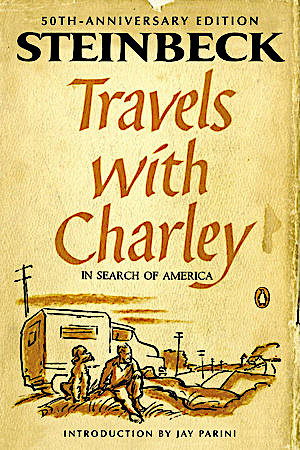 Travels
with Charley (1962) by John Steinbeck—Based on a
10,000-mile 1960 cross-country trip Steinbeck took
with his dog Charley in a camper named Rocinante,
this rambling memoir gives us the author’s take on
everything from eating lobster in Maine to a
Thanksgiving Day “orgy” in Amarillo. He travels
I-10, remarking on the imagination it took to
build an Interstate highway system for national
defense; of the great California redwoods, saying,
"The vainest, most
slap-happy and irreverent of men, in the
presence of redwoods, goes under a spell of
wonder and respect"; and saying his goodbyes to
the territories of his childhood, climbing
Fremont Peak and driving through his beloved
Salinas Valley. Written at a time of troubling
change in America, Steinbeck wrote of those he
encountered, “I
saw in their eyes something I was to see over
and over in every part of the nation—a burning
desire to go, to move, to get under way,
anyplace, away from any Here. They spoke quietly
of how they wanted to
Travels
with Charley (1962) by John Steinbeck—Based on a
10,000-mile 1960 cross-country trip Steinbeck took
with his dog Charley in a camper named Rocinante,
this rambling memoir gives us the author’s take on
everything from eating lobster in Maine to a
Thanksgiving Day “orgy” in Amarillo. He travels
I-10, remarking on the imagination it took to
build an Interstate highway system for national
defense; of the great California redwoods, saying,
"The vainest, most
slap-happy and irreverent of men, in the
presence of redwoods, goes under a spell of
wonder and respect"; and saying his goodbyes to
the territories of his childhood, climbing
Fremont Peak and driving through his beloved
Salinas Valley. Written at a time of troubling
change in America, Steinbeck wrote of those he
encountered, “I
saw in their eyes something I was to see over
and over in every part of the nation—a burning
desire to go, to move, to get under way,
anyplace, away from any Here. They spoke quietly
of how they wanted to go someday, to move
about, free and unanchored, not toward something
but away from something. I saw this look and
heard this yearning everywhere in every state I
visited. Nearly every American hungers to
move.”
go someday, to move
about, free and unanchored, not toward something
but away from something. I saw this look and
heard this yearning everywhere in every state I
visited. Nearly every American hungers to
move.”
The Great Railway Bazaar
(1975) by Paul Theroux—Written along what
was called the post-Beatles “hippie trail” to
India, this was a very new and different kind of
travel book in that it did not glamorize the
varnished wonders of all he saw but instead gave
an accurate portrait of the poverty, post-colonial
psyche of India and the travails of Asian trains.
He returned to Europe on the Trans-Iberian
Railway, but little of his four-month journey in
1973 was romantic in the traditional sense of
travel literature and therefore gives a truer
picture of the deprivations a wanderer should
expect. “Anything is
possible on a train,” he wrote, “ a great meal,
a binge, a visit from card players, an intrigue,
a good night's sleep, and strangers' monologues
framed like Russian short stories. . . . All
travel is circular. I had been jerked through
Asia, making a parabola on one of the planet's
hemispheres. After all, the grand tour is just
the inspired man's way of heading home. ”
 A Year in Provence (1989) by Peter Mayle—At first
intended as a novel, which never got written, all
but ignored by the critics upon publication and
rejected by every French publisher, this little paperback went
on to sell six million copies around the world. Mayle
wryly reported on about the trials and
tribulations, joys and discoveries, tastes and
smells of spending a year restoring a house with
the help and opposition of local farmers, lawyers,
unsavory builders and
a clarinet-playing plumber. The book was a
sensation as an invitation to a somewhat harried
rustic life among genuine eccentrics, and it
clicked in the hearts of both those who’d like
to take a shot at such a life and those who
could only dream of it. Despite many of Mayle’s
characterizations of the provincial French as
derogatory, come dinner time he said they “display the most
sympathetic side of their nature. Tell them
stories of physical injury or financial ruin and
they will either laugh or commiserate politely.
But tell them you are facing gastronomic
hardship, and they will move heaven and earth
and even restaurant tables to help you.”
What Mayle did for Provence, Frances Mayes would
do for Tuscany in her memoir Under the
Tuscan Sun
seven years later, not least to
push up the prices for even the shabbiest of
villas in that northern Italian region.
A Year in Provence (1989) by Peter Mayle—At first
intended as a novel, which never got written, all
but ignored by the critics upon publication and
rejected by every French publisher, this little paperback went
on to sell six million copies around the world. Mayle
wryly reported on about the trials and
tribulations, joys and discoveries, tastes and
smells of spending a year restoring a house with
the help and opposition of local farmers, lawyers,
unsavory builders and
a clarinet-playing plumber. The book was a
sensation as an invitation to a somewhat harried
rustic life among genuine eccentrics, and it
clicked in the hearts of both those who’d like
to take a shot at such a life and those who
could only dream of it. Despite many of Mayle’s
characterizations of the provincial French as
derogatory, come dinner time he said they “display the most
sympathetic side of their nature. Tell them
stories of physical injury or financial ruin and
they will either laugh or commiserate politely.
But tell them you are facing gastronomic
hardship, and they will move heaven and earth
and even restaurant tables to help you.”
What Mayle did for Provence, Frances Mayes would
do for Tuscany in her memoir Under the
Tuscan Sun
seven years later, not least to
push up the prices for even the shabbiest of
villas in that northern Italian region.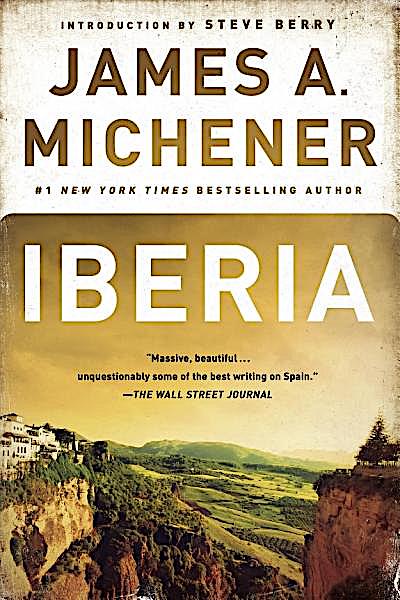
Iberia (1968) by James A.
Michener—Michener’s thousand-page novels like Hawaii, Centennial
and Space were
all based on extensive research going back and
forth in historical time as a background for the
fiction. Iberia
was one of his non-fiction door stoppers,
coming in at 818 pages, and what it lacked in
Hemingway’s style and insight about Spain it made
up for in detail, with each of thirteen chapters
focused on a region. He is particularly savvy
about Spanish food, describing, for example, a
platter of 21 entremes,
which were only the beginning of a four-course
meal to follow. As he observed, “To travel across Spain
and finally to reach Barcelona is like drinking
a respectable red wine and finishing up with a
bottle of champagne”—which seems just as true
today as when Michener wrote it.
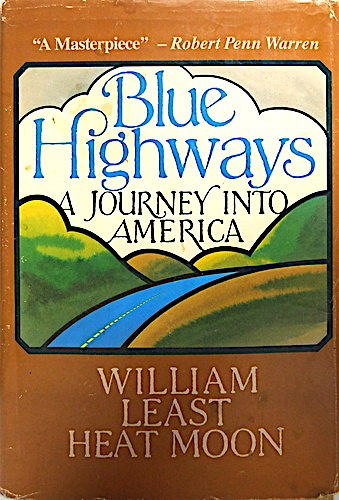
Blue Highways (1982) by William Least Heat
Moon—The title
refers to the secondary, blue-colored roads on
Rand McNally maps away from the Interstate
highways, which William Least Heat Moon traveled
after separating from his wife and his job. By
staying away from the cities, the author found the
rural American character can be quite different
from that of urban populations. His rule of the
blue road was, “Be careful going in search of
adventure—it’s ridiculously easy to find.”
❖❖❖
To read previous chapters go to archive (beginning with March 29, 2020, issue.

By John Mariani
Cover Art by Galina Dargery
CHAPTER THREE
Nicola
Santini loved Columbia University, with its
campus dominating Morningside Heights and
straddling its way up, down and across
Broadway and Amsterdam Avenue to 120th Street. She
felt a personal pride in the fact that the
campus architecture was done in the Italian
Renaissance style, dominated by the
neo-classical Low Library, whose
hundred-foot-tall dome paid homage to Rome’s
Pantheon.
It was a sober, classic style, in
deliberate contrast to the Neo-Gothic
architecture of Yale and Princeton and the
Georgian brick of Harvard. Nicola was equally
proud that she was among those second- and
third-generation Italians from the Bronx who
were accepted at the Ivy League school, and
she was sure that when her genius brother
Tommy graduated from Bronx High School of
Science, he would have his pick of any
university he wished to attend. Nicola
relished the musty smell in the halls of
academia, the echoes of voices and footsteps
in rooms with such high ceilings, even the
cigarette and pipe smoke that lingered in the
student lounge at Hamilton Hall and behind the
massive oak doors of every professor’s office.
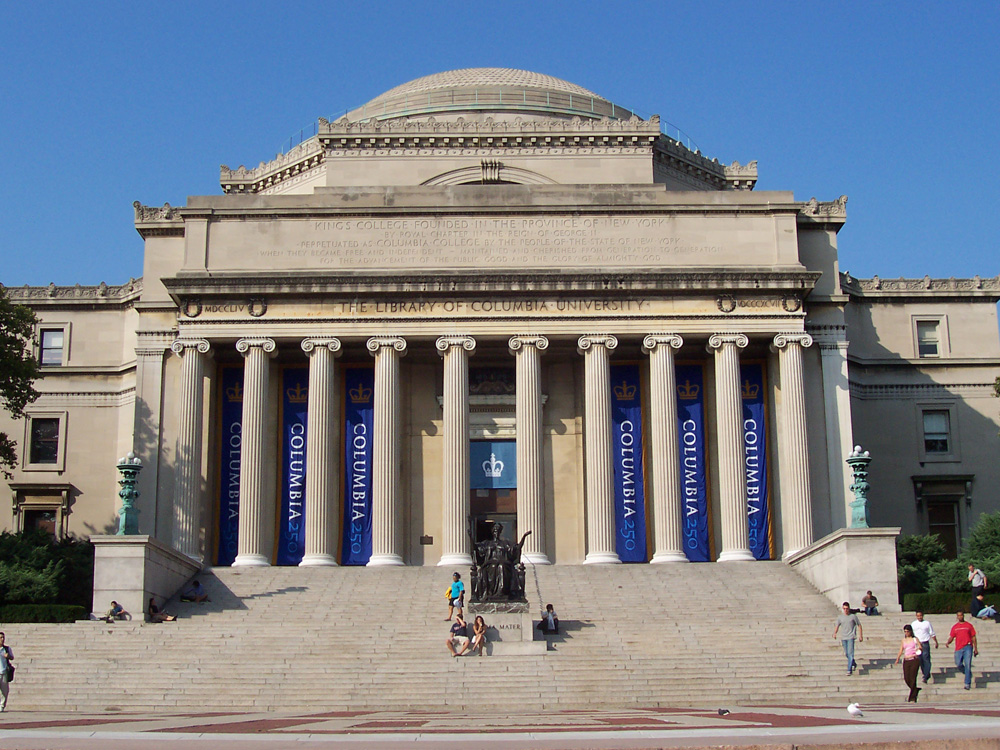 In
her first semester at Columbia, Nicola nursed
a slight inferiority complex, believing that
her fellow students might be far more
accomplished than she was, better traveled,
from wealthier neighborhoods than her own. Also,
the fact that she was a day student did not
engage her much with those who lived on
campus, and she deliberately chose not to join
one of the sororities, sensing that her
background might preclude her and that her
slight Bronx accent might cause other students
to wink at each other.
In
her first semester at Columbia, Nicola nursed
a slight inferiority complex, believing that
her fellow students might be far more
accomplished than she was, better traveled,
from wealthier neighborhoods than her own. Also,
the fact that she was a day student did not
engage her much with those who lived on
campus, and she deliberately chose not to join
one of the sororities, sensing that her
background might preclude her and that her
slight Bronx accent might cause other students
to wink at each other.
In
Belmont, where just about everyone was
Italian, she had never endured a single act of
bigotry—except that the older Italians
constantly made cracks about neighbors who
came from different provinces in the Old
Country.
The Calabrians complained about the
Neapolitans and the Neapolitans about the
Sicilians, and everyone complained about the
influx of Albanians and Croatians. But, out in
the wider world of Columbia, Nicola waited for
bigotry to rear its head. In
her first semester she even tried to modulate
her effusive hand movements and keep her
temper in tow, always eager for a serious
argument about art or religion or politics but
careful not to show too much of her Italian
streak of frustration when confronted by
someone she thought was being a total idiot. Biting
her tongue did not come easily to Nicola
Santini.
By the end of her freshman year,
however, there had been no such bigoted
incidents, other than having to respond again
and again to those naïve enough to ask her,
“So, up where you live, do you know, like,
Mafia guys?”
Nicola hated the question, which seemed
inevitable upon meeting non-Italians, and she
forced herself to hold in a desire to return
such slurs in kind, especially towards the
WASPs. What
she wanted
to say to them was, “You know, while my people
were creating the Renaissance, yours were
still painting their faces blue and worshiping
trees.”
Instead, she’d raise her eyes, shake
her beautiful head, and say, “I really thought
you were smarter than to ask such a dumb
question.”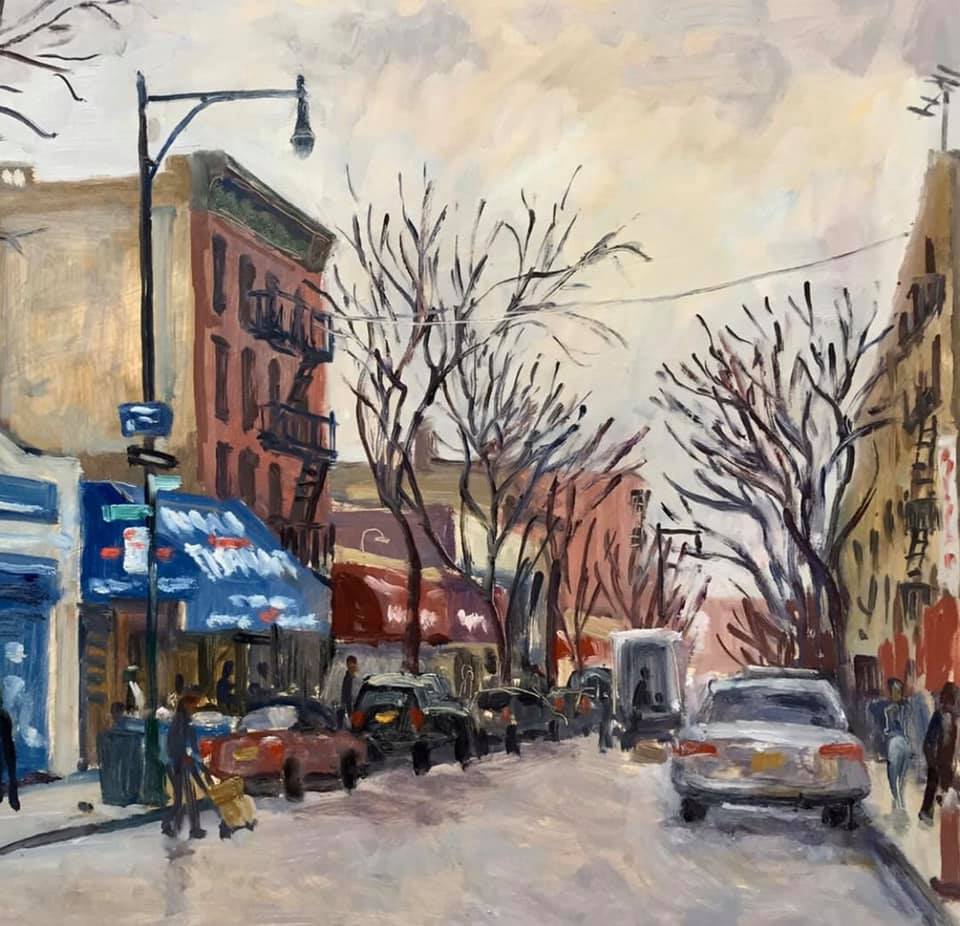
Belmont had, of course, a not
undeserved reputation as a place where
wiseguys once did business in their so-called
sports clubs, drinking endless cups of sweet
espresso and extorting everyone else. Nicola
knew
a few of the younger assholes trying to wedge
themselves into the mob, and she treated them
with utter contempt as morons more in
imitation of Hollywood stereotypes about
Italians than as men of dubious local honor.
Arthur Avenue at 187th Street
But by the ‘80s the
mob influence had faded, not least because few
of the wiseguys even lived in the neighborhood
any longer, moving instead to big houses in
Westchester, on Long Island, or in New Jersey,
only coming back to the old neighborhood
regularly to eat the kind of Italian-American
food they couldn’t find in towns with names
like Hartsdale, Hicksville and
Hackensack—ricotta-stuffed manicotti,
wine-splashed shrimp scampi and crisply fried
scungilli served at Bella Napoli, where,
occasionally, Nicola would help out as a
hostess on weekends to make money for
tuition.
Having been nurtured on her mother’s
and grandmother’s cooking, Nicola regarded
Bella Napoli’s food as no better than standard
Italian-American fare, with a huge menu
listing the usual baked ziti, lasagna, veal
parmigiana, and spaghetti and meatballs, all
of it lavished with the same marinara sauce
kept simmering in a large pot on the back of
the stove all day. Neither
did she care for the way so much of the food
was prepped far in advance, and she knew the
ingredients used could be of better quality,
especially since the restaurant sat right on a
street lined with good meat, seafood, bread,
vegetable and fruit markets. (Her
brother
Tony swore he’d change all that if he ever got
to buy the place.)
But she had no issue
with Bella Napoli’s pizza, which was widely
considered one of the best in the
neighborhood.
In fact, the New York Daily
News pronounced its  margherita pie the best in the
five boroughs, which resulted in the
restaurant’s owner, Joe Bastone, receiving a
wooden and brass plaque saying just that,
which he proudly hung on a fake brick wall
otherwise covered with signed black-and-white
photos of celebrities eating his glorious
tomato-mozzarella-basil-topped pizza with a
perfectly charred and bubbly crust that was
both crisp and chewy in all the right places.
margherita pie the best in the
five boroughs, which resulted in the
restaurant’s owner, Joe Bastone, receiving a
wooden and brass plaque saying just that,
which he proudly hung on a fake brick wall
otherwise covered with signed black-and-white
photos of celebrities eating his glorious
tomato-mozzarella-basil-topped pizza with a
perfectly charred and bubbly crust that was
both crisp and chewy in all the right places.
Joe had photos of dozens of
the Yankees—the Bronx Bombers’ Stadium was
just a fly ball away on 161st Street—Rizzuto,
DiMaggio, Mantle, Maris, as well as every
politician going after the Bronx vote—a
smiling Governor Nelson Rockefeller, a
squinting Mayor Ed Koch—as well as
Italian-American movie stars and singers like
Tony Bennett, Julius LaRosa, Vic Damone, Alan
Alda, Robert DeNiro, Ben Gazzara, Connie
Francis, and, of course, Dion DiMucci, lead
singer for the Belmonts. “I
swear to God,” Joe would say, “I served that
skinny kid enough damn pizza to sink the Andrea
Doria!”
But
Joe always regretted he could never get
Sinatra to come to Bella Napoli, despite
numerous promises by neighborhood bullshitters
who swore they knew him and would bring him
by. Joe
had even left an empty spot open on the wall,
“for when Sinatra comes in.”
Nicola
loved
the streets around Arthur Avenue, how
they rang with the sounds of store owners
singing "Oh Mari!
Quanta
suonno ca perdo per te”—“Oh, Marie, I
have lost so much sleep over you."
The air smelled of garlic and tomato, fresh
basil, and freshly ground coffee. Yankee
pennants festooned the storefronts, and old
men sat on folding chairs at their caffés to
watch the soccer games from Italy, sip
bittersweet liqueurs, and read the sports
pages of Il
Progresso.
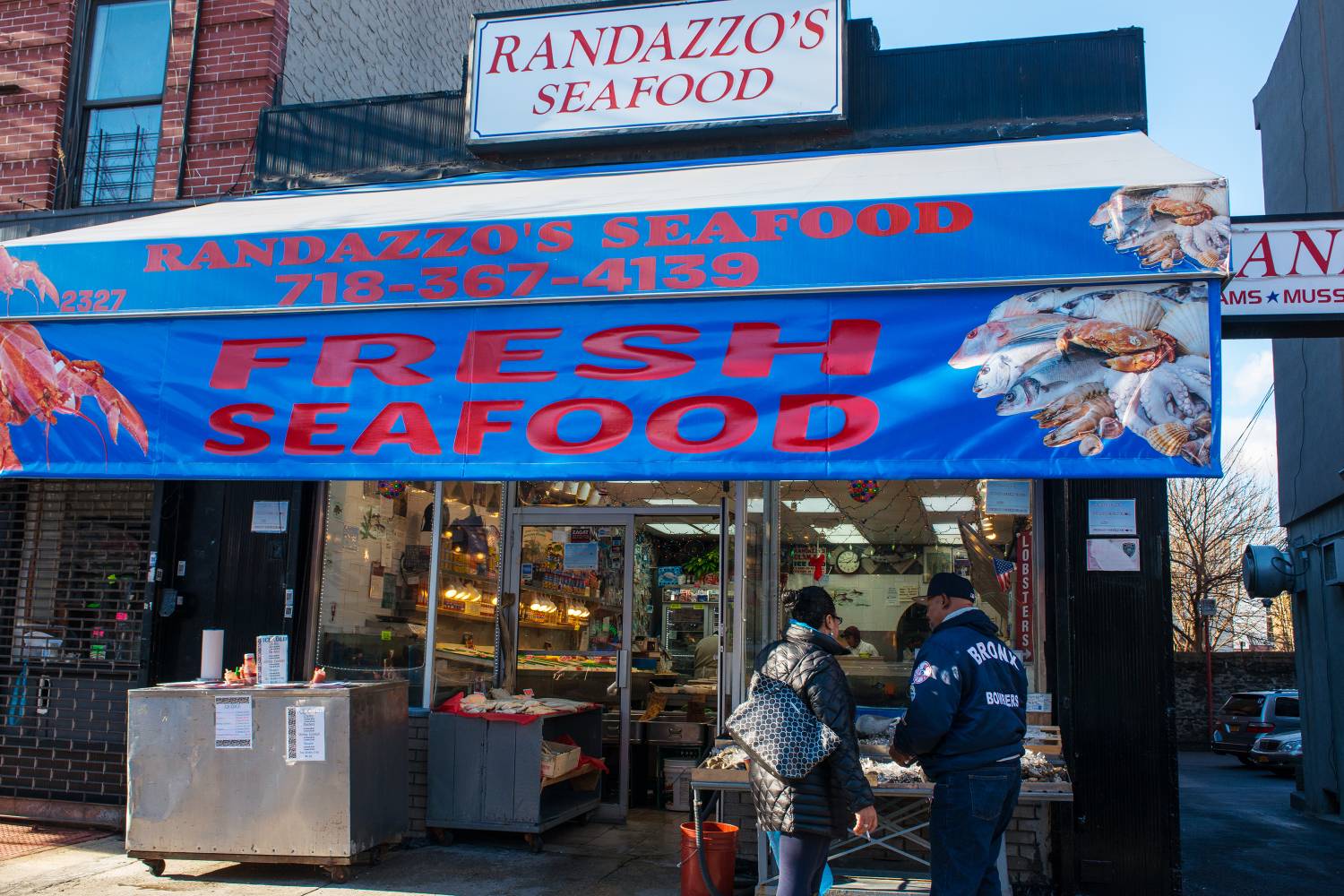
Outside Randazzo’s Fish Market, people
gobbled up fresh clams and oysters from the
ice counter; baby lambs hung in the window at
Biancardi’s Meats; in summer the pastry shops
brought out freezers with Italian ices—lemon,
chocolate, strawberry—scooped and patted into
little pleated paper cups; at the Calandra
Cheese store they sold fresh mozzarella and
ricotta, along with aged provolone and
parmigiano; across 187th Street at the Mt.
Carmel Candy Store they still made New York
egg creams—a masterfully rendered concoction
of U-Bet chocolate syrup, ice cold milk and
seltzer, no egg, no cream; at Borgatti’s
Noodles, three generations of the family cut
egg noodles into precise widths on a chugging
machine that rang the rafters off the
building; around the corner at Terranova
Bakery, men with fire-scarred arms pulled
steaming loaves from the city’s last
coal-fired oven, as much an historical
artifact as a symbol of the neighborhood’s
refusal to change. In fact, just that past
year, 1987, a movie called “Moonstruck”
starring Cher and Nicholas Cage used Terranova
for the bakery scenes.
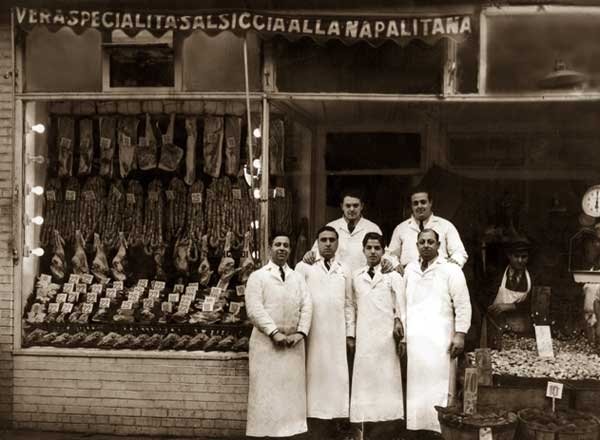
Nicola
enjoyed greeting the customers at Bella
Napoli, most of whom she knew, both those who
lived in the neighborhood and those who had
moved out of it. They still came back to
shop on the avenue and to eat in the
restaurants, so the pizza oven at Bella Napoli
was roaring from morning till
midnight—although Joe Bastone would serve
pizza after six p.m. only
if the customer also ordered other food. For
in those days, full-fledged Italian
restaurants played down the fact that they
were once mere pizzerias—then considered the
most common of street foods—no matter how
popular the pies were everywhere in America.
Biancardi's
Meats
Ah, but what they did to
pizza outside of New York! At
the drop of a moppine, Joe would roar his
disgust for what pizza had become
elsewhere—hell!—even in most parts of New York. Pizzas
had grown too large, too thick, packed with
too many disparate ingredients of low quality,
the mozzarella packaged and bought by the ton,
the tomato sauce out of a goddamn can, and the
crust!
He could not even imagine how his competitors
got the crust so grossly wrong, turning it
into thick, bread-like rounds that ended up
tasting like a goddamn hero loaf, chewy and
nothing more.
And if you were on very good terms with
Joe, which meant you were a regular customer
who told him his pizzas were absolutely the
best, he might confide that some of the
Belmont pizzerias were turning out crap, then
say, “I’ll kill you if you tell them what I
said.” Then
he’d smile, wave his hands in the air and go
back to the kitchen to stretch more dough—but
never like those idiots who tossed the stuff
in the air just for show.
So, even though Joe Bastone
had made his reputation and his principal
profit from his fabulous pizza, he wanted
people to love Bella 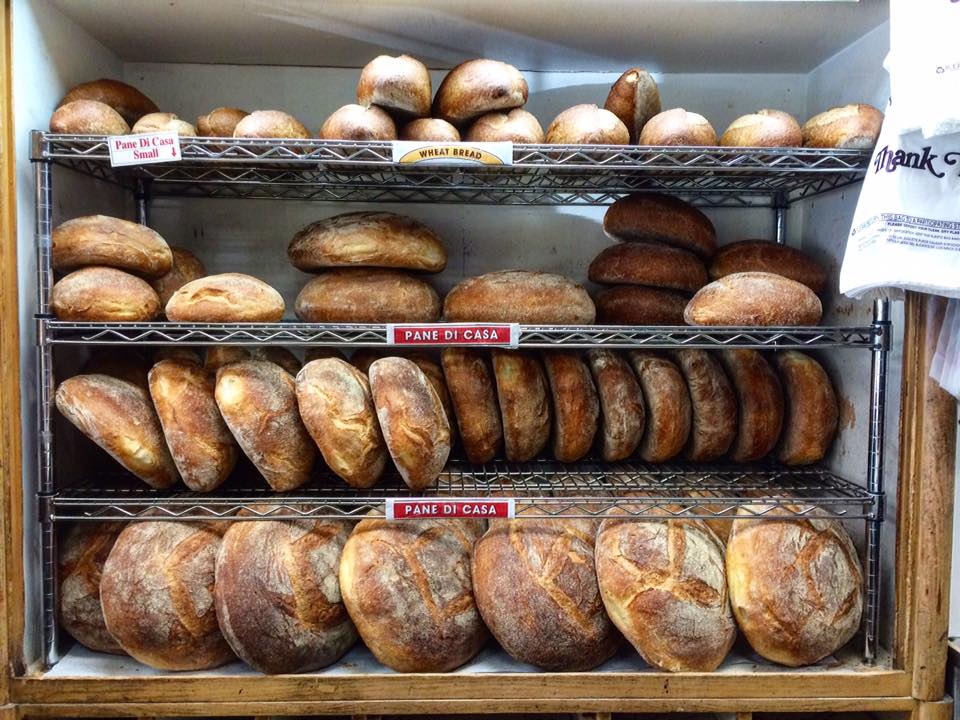 Napoli for its other
food, which was not nearly as good as those
nonpareil pies.
Nicola never said a word about it,
often waving off Joe’s offer to taste a new
dish by saying she was on a diet, to which Joe
would always say, “On a diet. Always
with the diet!
Nicky, you’re already too skinny for an
Italian girl. You gotta put some meat on those
bones, bella. Men
love the curves!”
Napoli for its other
food, which was not nearly as good as those
nonpareil pies.
Nicola never said a word about it,
often waving off Joe’s offer to taste a new
dish by saying she was on a diet, to which Joe
would always say, “On a diet. Always
with the diet!
Nicky, you’re already too skinny for an
Italian girl. You gotta put some meat on those
bones, bella. Men
love the curves!”
Nicola just nodded and smiled, well
aware that she had none of the voluptuary
curves of her sisters or of so many other
Italian women in the neighborhood. She
most certainly had a beautiful body, slim
hips, an enviable bust line, but it was her
face and her olive skin, dark brown eyes and
lustrous black hair that made every man who
came through the door at Bella Napoli fall in
love with her, and she’d developed a whole
patter for warding off the more obnoxious guys
who put the moves on her, sometimes while
their wives or girlfriends were eating
linguine three tables away.
Terranova Bakery
Of
course, she could also count on the protection
of Joe and her brother Tony, who, with typical
Italian bravado, both swore that Nicky was too
good for any of them, a fraternalistic opinion
she had long ago tired of hearing, as if she
were so unusual, so distant, so virginal that
no man could ever truly appreciate her for her
cultured demeanor or those virtues that had
been bred into her by her family.
Not since high
school, when she really was
very skinny, had Nicola had a boyfriend, a kid
who broke her heart by moving with his family
to Glen Cove, Long Island, promising he’d call
her and meet her in the city, but he never did
after moving out of the neighborhood. Afterwards
she found most of the Bronx guys strutted
their Italian macho with a swagger derived
from watching the first four “Rocky” movies,
even if the character of Rocky Balboa lived in
Philadelphia.
Her grandmother had told Nicola more
than once that it was not a bad thing to be a
little bit of a snob.
BELOVED
ITALIAN-AMERICAN RESTAURATEUR
JOSEPH MIGLIUCCI PASSES AWAY
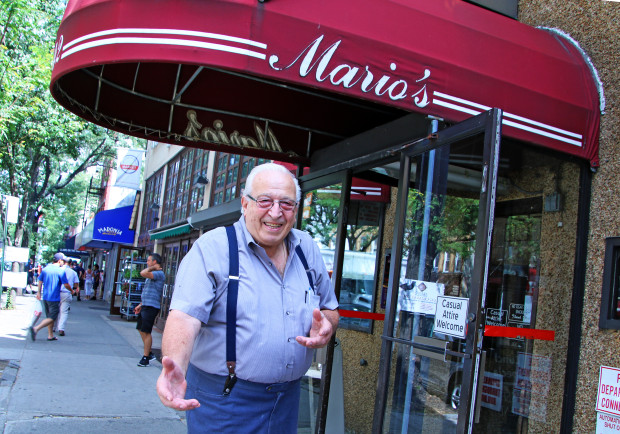 I
am very sorry to report that one of the great
men of Italian-American food has passed away,
owing to Covid-19. Joseph Migliucci, co-owner
with his family of Mario’s restaurant on
Arthur Avenue in the Bronx, was part of five
generations who kept the flame of
Italian-American cooking alive and well.
I
am very sorry to report that one of the great
men of Italian-American food has passed away,
owing to Covid-19. Joseph Migliucci, co-owner
with his family of Mario’s restaurant on
Arthur Avenue in the Bronx, was part of five
generations who kept the flame of
Italian-American cooking alive and well.
Mario’s opened a century
ago in the Belmont neighborhood of the Bronx
as a pizza window shop and expanded into a
full-service restaurant in the 1930s. Mario
Migliucci and his wife, Rose, with their
children, Joe and Diane, then grandchildren,
always ran the place like a true family
restaurant, and it was where countless family
parties were held week after week.
After Mario’s death in 1998, and Rose’s
ten years later, Joseph and his wife, Barbara,
and today his daughter Regina, kept the
restaurant going with the same degree of
energy, passion and familial cordiality.
You’d never leave Mario’s without a
member of the family coming over to make sure
you enjoyed your meal. Usually it was Joe, who
demonstrated the rare but enduring benevolence
that seems so often absent from today’s trendy
new Italian restaurants and pizzerias around
town, where people are rushed in, rushed out,
with a “who-gets-what?” attitude and a stiff
bill at the end.
There are still double
tablecloths, long banquettes, good lighting
and carts are still wheeled from the kitchen
brimming with pizzas, cold and hot antipasti,
steaming pastas, generous main courses and
old-fashioned desserts.
The walls are lined with photos of
everyone who dined there, from Paul Newman to
Muhammad Ali and every New York Yankee, who
came from the Stadium nearby.
Joe
was a big, sweet, gentle giant, beloved by
everyone who frequented his wonderful
restaurant. Mario’s pizzas were famous, the
old-fashioned decor was cherished, and he
rarely took a day off, not only because he
convinced himself that something or somebody
in the restaurant needed his attention, but
because he knew that was where he was
happiest. Mario's just celebrated its 100th
anniversary, and Joe was there for 81 of them.
I’ll miss him so much.
By John Mariani
DOMAINE BOUSQUET WINES OF ARGENTINA
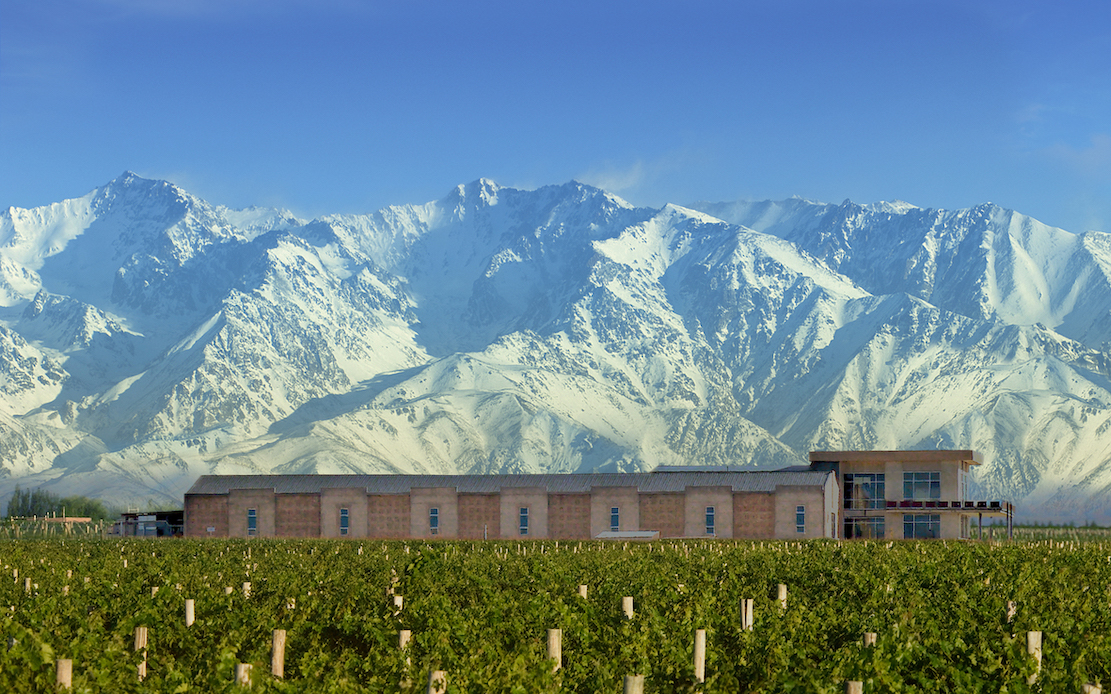
The growth and acceptance of
Argentinean wines in the global market, despite
the country’s boom-or-bust economy, is largely the
result of investments made and vineyards planted
just in the past 20 years. Today Argentina is the
world’s fifth largest wine producer (after France,
Italy, Spain and the U.S.), with more than 900
wineries and 17,000 producers. Total exports in
2019 were 19 million cases totaling $700 million
in sales.
Innovators like Bodegas Salentein, BenMarco and Susanna
Balbo have helped Argentina’s wines compete with
those of France and Italy. One of the pioneers of modern
Argentinean winemaking is Domaine Bousquet, which
was founded by a
third generation vintner from Carcassone,
France, named Jean Bouquet, and is now the
country’s largest, exporting 95% of their total
production of 4 million liters to more than 50
countries, totaling 5.6 million cases and $230
million in sales.
Guillaume Bousquet, Anne
Bousquet, Labid Al Ameri, Eva Al Ameri
Bousquet was on vacation in
Argentina in 1990 when he found that the terroir of
the remote, high-altitude Gualtallary Valley of
Argentina’s Mendoza region would be the ideal
location for him to make natural organically grown
wines.
I spoke with Bousquet’s daughter
Anne, an economist by training who as CEO now runs
the company with her husband, Labid Al Ameri,
a successful trader with Fidelity in Boston and now
president of the winery. Al Ameri joined the company
in 2005, Anne in 2008. A year later they moved to
Tupungato full-time, assuming full ownership of
Domaine Bousquet in 2011 (though they now live in
Miami, Florida).
I asked Anne Bousquet what appealed to her
father about the Gualtallary Valley.
“It was the altitude,” she said,
“ranging up to 5,249 feet, which
are the highest extremes of Mendoza’s
viticultural limits. Fast-forward to the present and
wine cognoscenti now recognize it as the source of
some of Mendoza’s finest wines. Back then, it was
virgin territory: tracts of semi-desert, nothing
planted, no water above ground, no electricity and a
single dirt track by way of access. Locals dismissed
the area as too cold for growing grapes.
“My father, on the other hand,
reckoned he’d found the perfect blend between his
French homeland and the New World—sunny, with 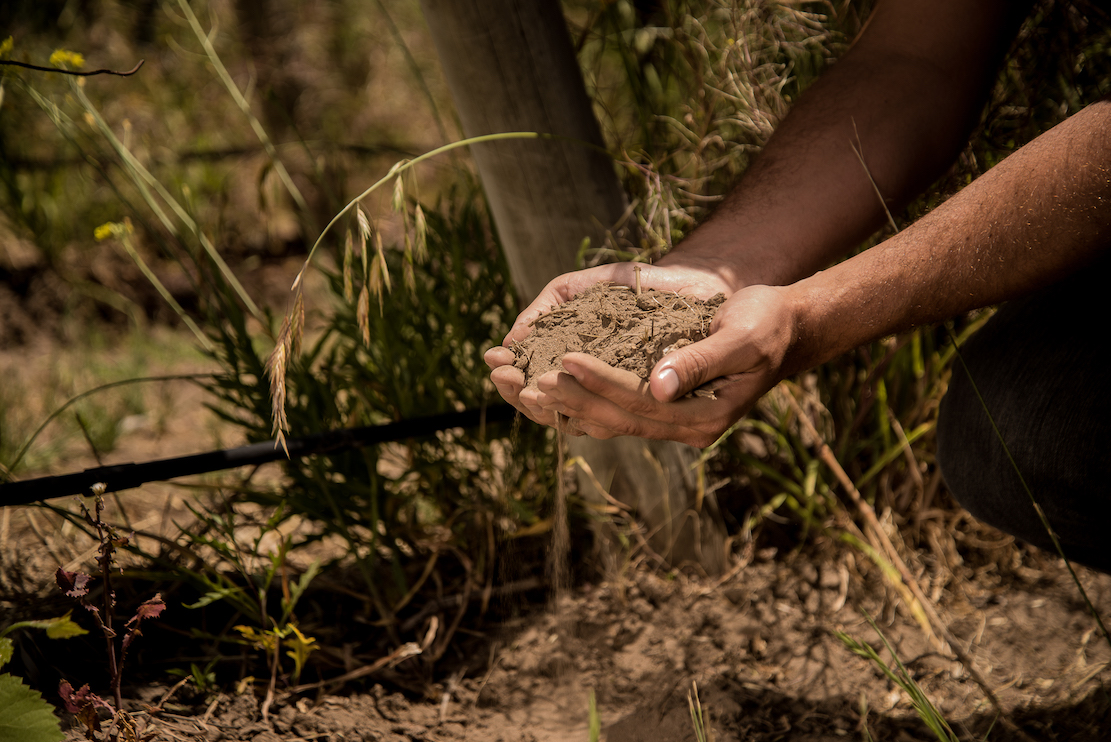 high natural acidity and a potential
for relatively fruit-forward wines.”
high natural acidity and a potential
for relatively fruit-forward wines.”
The first harvest was in 2003.
Winemaker Rodrigo Serrano joined Bousquet in late
2017.
“Before 2000 Uco Valley
was not exploited, and most of the wineries were
located near Mendoza city at a lower elevation,”
said Anne. “Now a lot of the wineries own
vineyards in Uco Valley. Also Argentina’s wine
industry was not as strong in exports in the 1990s;
they only started to grow significantly during the
2000s.”
Today, in order to meet
production, Bousquet grows fifty percent of its
grapes on 600 acres of land and buys the rest from
local farmers.
From the beginning the family was
devoted to sustainability and maintaining the land
in the healthiest condition. Irrigation is done
through a drop-by-drop system harnessing the Andean
Mountains’ run-off, which creates a lower ph in the
grapes, leading to higher acidity and color in the
wine. The sandy soil drainage makes the grapes
“stress” to obtain water, and the desert climate can
swing as much as 59 degrees in temperature from
morning through night. No synthetic pesticides,
herbicides or fertilizers are used. Bousquet is now
making non-sulfite wines under the Virgen label—a
red blend of Malbec, Cabernet Sauvignon and Cabernet
Franc in 2018, and a Merlot in 2019. For that series
the wines spend no time in oak.
I asked Anne how Bousquet
copes in a world with a serious glut of wine supply.
“We intend to continue to compete
through our advantage, which is that all our wines
are made with certified organic grapes, and now we
also produce non-sulfite added wines,” she
said. “We have now established ourselves as
the leading Argentine winery for organic wines at a
time when demand for organic produce and wines has
been trending upward for the past few years in North
America and Europe (our strongest markets) and we
expect this trend to continue over the next few
years.”
She is more optimistic about
sales in China than many competitors I’ve
interviewed are at the moment. “China is a good
market,” she said,“but Argentina in general competes
in the Chinese market with wines from Europe, Chile
and Australia.”
I asked how global warming has
affected Bousquet’s viticulture. “Global warming
generally affects the timing and length of the
harvest,” she said. “This year, for example, the end
of the summer was very hot, and we started harvest
earlier than other years, and we will also finish
harvesting earlier. Another effect of global
warming is 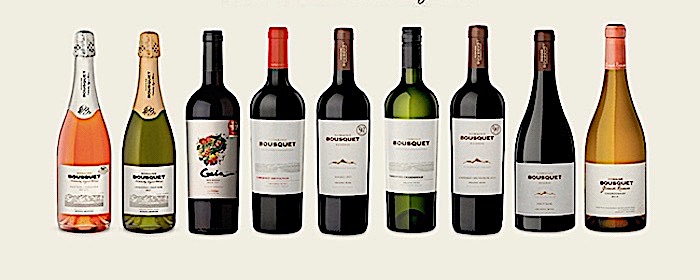 that there is a lot less
snowfall during the winter compared to 15 or 20
years ago, which means that there is much less water
available for irrigation for agriculture. This led
the Mendoza government to stop authorizing new wells
several years ago, which in turn limits the growth
in new vineyards.”
that there is a lot less
snowfall during the winter compared to 15 or 20
years ago, which means that there is much less water
available for irrigation for agriculture. This led
the Mendoza government to stop authorizing new wells
several years ago, which in turn limits the growth
in new vineyards.”
Bousquet makes a remarkable range of
ten different labels, which range from Virgen and Premium Varietals
to sparkling wines, special editions and Gaia, this last
sold only to restaurants. I tasted several of their
line and was impressed with their quality first,
then their price. The Virgen Malbec, Cabernet
Sauvignon and Red Blend cost $13 a bottle; the
excellent Reserve Chardonnay $18; the Sparkling Charmat Method
Pinot-Noir –Chardonnay $13; and the Gaia
restaurant wines $20. The Ameri Malbec Blend
at the top of their line is $36.
Domaine Bousquet, together
with the other big names in Argentinean wines, is
offering some of the best values for varietals that
might well cost double the price of those from other
countries. In an industry where margins are slimmer
than they used to be, Domaine Bousquet seems to have
a very wide niche carved out for itself.
Any of John Mariani's books below may be ordered from amazon.com.
 The Hound in Heaven
(21st Century Lion Books) is a novella, and
for anyone who loves dogs, Christmas, romance,
inspiration, even the supernatural, I hope you'll find
this to be a treasured favorite. The story
concerns how, after a New England teacher, his wife and
their two daughters adopt a stray puppy found in their
barn in northern Maine, their lives seem full of promise.
But when tragedy strikes, their wonderful dog Lazarus and
the spirit of Christmas are the only things that may bring
his master back from the edge of despair.
The Hound in Heaven
(21st Century Lion Books) is a novella, and
for anyone who loves dogs, Christmas, romance,
inspiration, even the supernatural, I hope you'll find
this to be a treasured favorite. The story
concerns how, after a New England teacher, his wife and
their two daughters adopt a stray puppy found in their
barn in northern Maine, their lives seem full of promise.
But when tragedy strikes, their wonderful dog Lazarus and
the spirit of Christmas are the only things that may bring
his master back from the edge of despair. WATCH THE VIDEO!
“What a huge surprise turn this story took! I was completely stunned! I truly enjoyed this book and its message.” – Actress Ali MacGraw
“He had me at Page One. The amount of heart, human insight, soul searching, and deft literary strength that John Mariani pours into this airtight novella is vertigo-inducing. Perhaps ‘wow’ would be the best comment.” – James Dalessandro, author of Bohemian Heart and 1906.
“John Mariani’s Hound in Heaven starts with a well-painted portrayal of an American family, along with the requisite dog. A surprise event flips the action of the novel and captures us for a voyage leading to a hopeful and heart-warming message. A page turning, one sitting read, it’s the perfect antidote for the winter and promotion of holiday celebration.” – Ann Pearlman, author of The Christmas Cookie Club and A Gift for my Sister.
“John Mariani’s concise, achingly beautiful novella pulls a literary rabbit out of a hat – a mash-up of the cosmic and the intimate, the tragic and the heart-warming – a Christmas tale for all ages, and all faiths. Read it to your children, read it to yourself… but read it. Early and often. Highly recommended.” – Jay Bonansinga, New York Times bestselling author of Pinkerton’s War, The Sinking of The Eastland, and The Walking Dead: The Road To Woodbury.
“Amazing things happen when you open your heart to an animal. The Hound in Heaven delivers a powerful story of healing that is forged in the spiritual relationship between a man and his best friend. The book brings a message of hope that can enrich our images of family, love, and loss.” – Dr. Barbara Royal, author of The Royal Treatment.
 |
The Encyclopedia of American Food and Drink by John F. Mariani (Bloomsbury USA, $35) Modesty forbids me to praise my own new book, but let me proudly say that it is an extensive revision of the 4th edition that appeared more than a decade ago, before locavores, molecular cuisine, modernist cuisine, the Food Network and so much more, now included. Word origins have been completely updated, as have per capita consumption and production stats. Most important, for the first time since publication in the 1980s, the book includes more than 100 biographies of Americans who have changed the way we cook, eat and drink -- from Fannie Farmer and Julia Child to Robert Mondavi and Thomas Keller. "This book is amazing! It has entries for everything from `abalone' to `zwieback,' plus more than 500 recipes for classic American dishes and drinks."--Devra First, The Boston Globe. "Much needed in any kitchen library."--Bon Appetit. |
"Eating Italian will never be the same after reading John Mariani's entertaining and savory gastronomical history of the cuisine of Italy and how it won over appetites worldwide. . . . This book is such a tasteful narrative that it will literally make you hungry for Italian food and arouse your appetite for gastronomical history."--Don Oldenburg, USA Today. "Italian
restaurants--some good, some glitzy--far
outnumber their French rivals. Many of
these establishments are zestfully described
in How Italian Food Conquered the World, an
entertaining and fact-filled chronicle by
food-and-wine correspondent John F.
Mariani."--Aram Bakshian Jr., Wall Street
Journal.
"Equal parts
history, sociology, gastronomy, and just
plain fun, How Italian Food Conquered the
World tells the captivating and delicious
story of the (let's face it) everybody's
favorite cuisine with clarity, verve and
more than one surprise."--Colman Andrews,
editorial director of The Daily
Meal.com. "A fantastic and fascinating
read, covering everything from the influence
of Venice's spice trade to the impact of
Italian immigrants in America and the
evolution of alta cucina. This book will
serve as a terrific resource to anyone
interested in the real story of Italian
food."--Mary Ann Esposito, host of PBS-TV's
Ciao
Italia. "John Mariani has written the
definitive history of how Italians won their
way into our hearts, minds, and
stomachs. It's a story of pleasure over
pomp and taste over technique."--Danny Meyer,
owner of NYC restaurants Union Square
Cafe, The Modern, and Maialino.
|
 |
 |
 |
 |
 |
 |
 |
 |
 Everett Potter's Travel Report:
Everett Potter's Travel Report: 
 Eating Las Vegas
JOHN CURTAS has been covering the Las Vegas
food and restaurant scene since 1995. He is
the co-author of EATING LAS VEGAS – The 50
Essential Restaurants (as well as
the author of the Eating Las Vegas web site: www.eatinglasvegas.
He can also be seen every Friday morning as
the “resident foodie” for Wake Up With the
Wagners on KSNV TV (NBC) Channel 3 in
Las Vegas.
Eating Las Vegas
JOHN CURTAS has been covering the Las Vegas
food and restaurant scene since 1995. He is
the co-author of EATING LAS VEGAS – The 50
Essential Restaurants (as well as
the author of the Eating Las Vegas web site: www.eatinglasvegas.
He can also be seen every Friday morning as
the “resident foodie” for Wake Up With the
Wagners on KSNV TV (NBC) Channel 3 in
Las Vegas.
MARIANI'S VIRTUAL GOURMET
NEWSLETTER is published weekly. Publisher: John Mariani. Editor: Walter Bagley. Contributing Writers: Christopher Mariani,
Robert Mariani, Misha Mariani, John A. Curtas, Gerry Dawes, Geoff Kalish,
and Brian Freedman. Contributing
Photographer: Galina Dargery. Technical
Advisor: Gerry
McLoughlin.
If you wish to subscribe to this
newsletter, please click here: http://www.johnmariani.com/subscribe/index.html
© copyright John Mariani 2020

